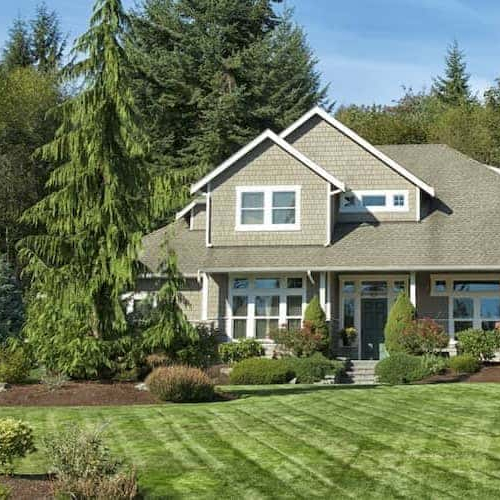Fixed- vs. adjustable-rate mortgage: What’s the difference?
Contributed by Sarah Henseler, Tom McLean
May 9, 2025
•6-minute read

If you’re looking to buy or refinance a home, you want to pay as little interest as possible. But sometimes it’s not a simple matter of picking the lowest number. Adjustable-rate mortgages offer lower introductory rates than fixed-rate mortgages, but they may not stay that way. We’ll compare an ARM vs. a fixed-rate mortgage so that you can make an informed decision about which option is best for you.
What is a fixed-rate mortgage?
The interest rate on a fixed-rate mortgage stays the same throughout the life of the loan. This means your monthly payment for principal and interest doesn’t change.
Fixed-rate mortgages are the most popular type of mortgage because the monthly payment is predictable. This certainty comes at the cost of the potential for a lower rate with an adjustable-rate mortgage, but you’re also guarding against the risk of the rate going higher.
What is an ARM?
An adjustable-rate mortgage has an interest rate that changes over time. You may hear these referred to as variable-rate mortgages. ARMs usually employ what’s called a hybrid structure. In a hybrid ARM, rates are fixed initially, often for 5, 7, or 10 years. The total loan term is usually 15 or 30 years. Adjustment intervals vary. In a 5/1 loan, it means the interest rate is fixed for 5 years and adjusts every year after that. In a 5/6 loan, the rate changes every 6 months after the initial fixed period. Adjustments move with indexes like the secured overnight financing rate or constant maturity treasury, subject to caps and floors.
What are the differences between fixed- and adjustable-rate mortgages?
The primary difference between a fixed-rate mortgage and an ARM is that the interest rate changes on the latter, though there are some nuances to that.
Margins
Your loan documentation will specify the margin for your loan. The margin is a percentage set by the lender so there’s a minimum return received on the loan to cover the lender’s overhead. Your overall interest rate is the index number added to the margin. If there’s a 2% margin and the underlying index for your adjustments is at 4.5%, your interest rate would be 6.5%.
Every lender has different policies regarding margins, but they could be as high as a few percentage points, depending on the loan investor. You can look at the margin when you’re comparing lenders.
Rate caps and floors
ARMs have limits to how much rates can rise or fall over specific time periods. You may see caps and floors listed with a series of slashes like 2/1/5. The 2 means that your rate can’t fall or rise more than 2% on the first adjustment. The 1 means that the rate can’t go up or down by more than 1% with each subsequent adjustment. The 5 means that your rate won’t go up more than 5% over the life of the loan. The last number may also serve as a floor, or the lender may rely on their margin as the lower bound for the rate.
Lower initial rates
ARMs have lower interest rates than comparable fixed-rate mortgages initially because the rate can be adjusted in the future.
Ease of qualification
The qualifications for a fixed-rate mortgage vs. an ARM are similar. Fixed--rate mortgages might allow you to qualify with a higher debt-to-income ratio because the consistent payment presents less risk of default. Other factors like your down payment amount or home equity and your credit score also apply.
How are ARMs and fixed-rate mortgages similar?
Fixed-rate mortgages and ARMs do have some similarities, including the length of the loans and how you go about qualifying.
Term length
Although fixed-rate mortgages offer more variety in terms of the potential length of the mortgage, both are often based on a 30-year or 15-year term.
When it comes to comparing the two, fixed-rate mortgages offer certainty. If you get an adjustable-rate mortgage, you’re hoping for savings, but also risking a higher rate.
To get an idea of the variability, let’s look at a couple of scenarios with a $300,000 loan amount and 30-year term. One will be a 7/1 ARM with 2/1/5 caps and a 3% margin at an initial rate of 6.5%. The other will be a fixed-rate mortgage with a 7% interest rate.
This table is oversimplified, but it’s intended to show the best- and worst-case scenario for the ARMs. Payments don’t include taxes and insurance.
| Payment over time | Fixed-rate mortgage | ARM high | ARM low |
|---|---|---|---|
| Initial rate | $1,995.91 | $1,896.20 | $1,896.20 |
| Year 8 | $1,995.91 | $2,065.26 | $1,734.06 |
| Year 9 | $1,995.91 | $2,235.64 | $1,584.32 |
| Year 10 | $1,995.91 | $2,406.66 | $1,447.07 |
| Year 11 | $1,995.91 | $2,577.71 | $1,383.79 |
| Year 12 | $1,995.91 | $2,748.21 | $1,383.79 |
| Total interest paid | $418,526.69 | $597,296.10 | $248,575.79 |
Credit requirements
We’ve talked about DTI, but it’s not the only thing that lenders look at. It’s also a good idea to pay attention to your credit score, which is a three-digit number that gives lenders an idea of the risk associated with lending to you.
Conforming and VA loans have no specific minimum credit score, but lenders can set their own requirements. Historically, 580 – 620 has been a good minimum to target. But the higher your score is, the better the interest rate you can qualify for.
If your score isn’t what you would like it to be, check your credit report for mistakes, pay down existing debts and try to keep your revolving credit card balances under 30% of your overall credit limit.
Which is better: A fixed- or adjustable-rate mortgage?
So, which is better: an ARM or a fixed-rate loan? The short answer: it depends.
When adjustable-rate mortgages may be good
- Lowering the principal balance early: If you plan on putting more toward your mortgage balance early in the loan by making extra payments, an ARM may be attractive because the actual payment is lower at the beginning of the loan. You can put extra money toward the balance and have a relatively lower payment when the rate adjusts.
- Those who plan on buying another home: If this is a starter home for you and you don’t plan on owning it long, you can take advantage of an ARM for the lower payment and sell before the rate adjusts.
- A high-interest-rate market: If current mortgage rates are running high, it can be beneficial to look into an ARM because the initial rate is going to be lower than fixed rates. When the adjustment happens, rates will fall if market rates are lower. You can also refinance into a fixed rate at that time if you find it more favorable.
When fixed-rate mortgages may be good
- Buying your “forever home”: If this is going to be your home for the foreseeable future, a fixed rate can provide budget certainty. Your mortgage payment would only change with updated tax or insurance payments.
- Tight monthly budgets: While ARMs offer lower initial payments, you’re taking a big risk that the payment is going to go up when you see the first adjustment. If you are on a tight budget, going with a fixed rate could give more peace of mind.
- A low interest market: Interest rates are cyclical. If you find yourself in a market with relatively low interest rates, you may choose to lock in a fixed rate so you have a payment you can afford well into the future.
FAQs
We’ve run through many of the basics. Let’s close by answering a few lingering questions you may have.
Is a fixed-rate mortgage or adjustable-rate mortgage riskier?
ARMs are riskier for borrowers because the interest rate changes periodically based on market movement. Fixed-rate mortgages have the same payment from beginning to end.
Is an ARM or fixed-rate mortgage easier to qualify for?
Depending on the interest rate environment and the rate the lender is using to qualify you, it may be easier to qualify for an ARM in certain circumstances. But there are similar credit requirements associated with both.
What is the penalty for leaving a fixed-rate mortgage?
The only real penalty for leaving any mortgage is the prepayment penalty you may be charged if you pay off your mortgage prior to a date specified in your contract. While it’s not a penalty, it’s fair to say that there is a risk going from a fixed-rate mortgage to an ARM that your interest rate will eventually rise.
The bottom line: Consider all your interest rate options
Choosing between a fixed-rate mortgage and ARM comes down to your personal situation and risk tolerance. A fixed-rate mortgage can provide peace of mind when it comes to the payment, but ARMs start with lower rates. This could be useful if you want to pay down your balance early while benefiting from the lower initial payment. ARMs can also be good if you think you’ll move shortly. Fixed rates can be better long-term.
Do you want to check out your options? You can apply online with Rocket Mortgage.
Kevin Graham
Kevin Graham is a Senior Writer for Rocket. He specializes in mortgage qualification, economics and personal finance topics. Kevin has passed the MLO SAFE exam given to mortgage bankers and takes continuing education courses. As someone with cerebral palsy spastic quadriplegia that requires the use of a wheelchair, he also takes on articles around modifying your home for physical challenges and smart home tech. He has a BA in Journalism from Oakland University.
Related resources
6-minute read
Can you refinance an ARM loan?
Yes, you can refinance an ARM loan. You may even be able to get a fixed-rate loan instead. But before you refinance, consider these key factors.
Read more

4-minute read
Convertible ARM loan: Is it right for you?
A convertible ARM loan allows a borrower to change from adjustable to fixed rates after a set time. Discover how this mortgage type works and its pros and co...
Read more

5-minute read
Adjustable-rate mortgages: The pros and cons
Adjustable-rate mortgages start with lower interest rates that later adjust, affecting your monthly payment. Learn more about the pros and cons of an ARM.
Read more